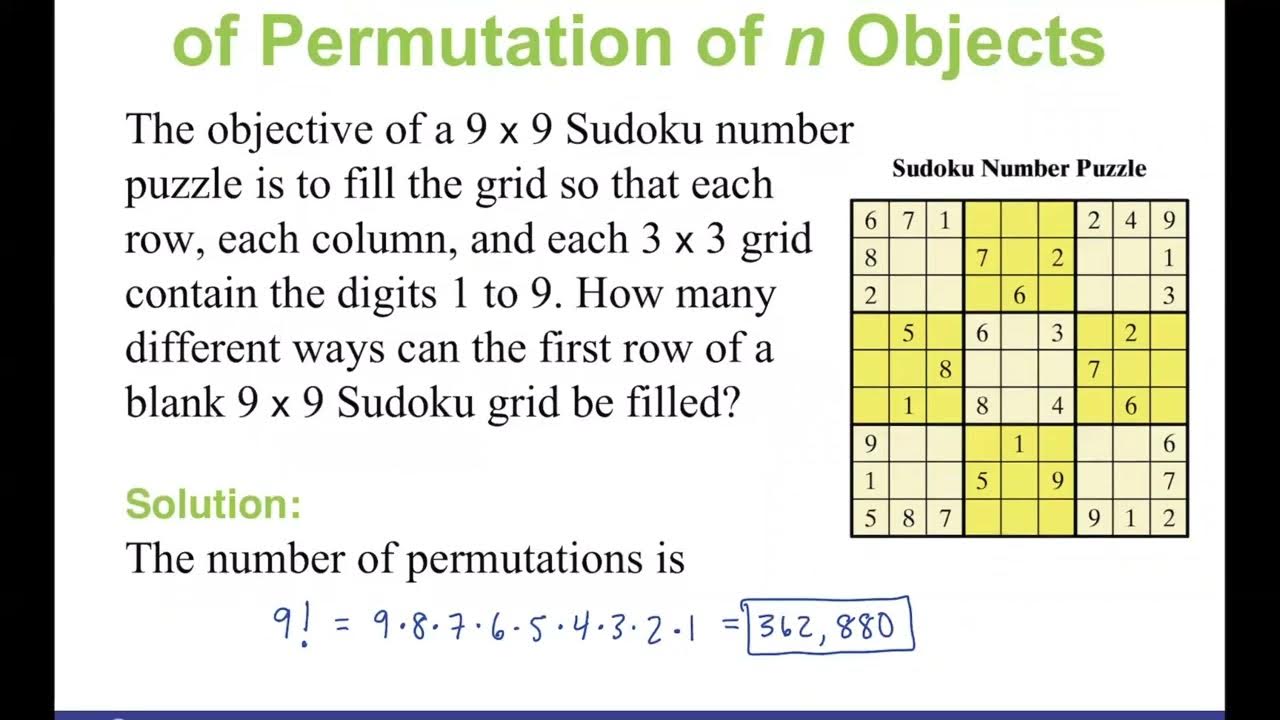FAKTORIAL, PERMUTASI, DAN KOMBINASI | Video Pembelajaran Matematika
Summary
TLDRThis educational video covers the concepts of factorials, permutations, and combinations. It explains how factorials represent the product of consecutive natural numbers, and how to apply permutation formulas for arrangements of distinct elements, including circular permutations. The video also explores combinations, focusing on how to calculate the number of ways to select a subset of elements. Examples are provided for each concept, showing real-life applications like choosing class leaders or organizing a meeting. The key takeaway is understanding the differences between permutations (where order matters) and combinations (where order does not).
Takeaways
- 😀 Factorial is the product of all positive integers up to a given number n. For example, 5! = 5 × 4 × 3 × 2 × 1 = 120.
- 😀 Factorial is undefined for negative numbers. For example, (-6)! is not defined.
- 😀 Permutation refers to the arrangement of distinct items in a specific order without repetition.
- 😀 The formula for permutation when arranging n distinct items in r positions is: P(n, r) = n! / (n - r)!
- 😀 A class choosing a president and vice-president from 6 candidates would have 30 possible ways to make the selection using permutations.
- 😀 When calculating permutations of words with repeated letters, the formula is adjusted by dividing by the factorials of the repeated letters.
- 😀 Example: The word 'pencacahan' can be arranged in 151,202 different ways, considering the repeated letters.
- 😀 Circular permutations involve arranging objects in a circle, with the formula for n objects being: P_circular(n) = (n - 1)!
- 😀 In circular permutations where specific people must sit together, treat them as one block and adjust the formula accordingly.
- 😀 Combinations are different from permutations because the order does not matter, and they refer to the selection of items without repetition.
- 😀 The formula for combinations is: C(n, r) = n! / (r! * (n - r)!), where n is the total items and r is the items chosen.
- 😀 In the case of 25 people shaking hands, there are 300 unique handshakes possible, calculated using combinations.
- 😀 The key difference between permutations and combinations is that permutations consider the order of items, whereas combinations do not.
Q & A
What is the definition of a factorial?
-A factorial is the product of all positive integers up to a given number 'n'. It is denoted as n! and can be calculated by multiplying n by (n-1), (n-2), and so on down to 1.
How do you calculate 5 factorial?
-To calculate 5 factorial (5!), you multiply 5 by 4 by 3 by 2 by 1, which equals 120.
What is the formula for factorial?
-The formula for factorial is n! = n * (n-1) * (n-2) * ... * 1.
Can factorial be calculated for negative numbers?
-No, factorials are not defined for negative numbers. The factorial function only applies to non-negative integers.
What is the concept of permutation?
-Permutation refers to the arrangement of 'n' distinct elements in a specific order, where order matters and no element is repeated.
What is the formula for a simple permutation?
-The formula for a simple permutation is P = n! / (n-k)!, where n is the total number of elements, and k is the number of elements to arrange.
How many ways can a class of 6 students elect a chairman and a vice-chairman?
-The number of ways to elect a chairman and a vice-chairman from 6 students is calculated using the permutation formula P = 6! / (6-2)!, which equals 30.
What is a permutation involving repeated elements?
-When some elements are repeated in a set, the formula for permutation becomes P = n! / (k1! * k2! * ... * kn!), where k1, k2, ..., kn represent the frequencies of the repeated elements.
How do you calculate the number of distinct words that can be formed from the word 'pencacahan'?
-To calculate the number of distinct words from 'pencacahan', use the formula P = 10! / (2! * 3! * 2!), where 10 is the total number of letters, and the factorials of the repeated letters (n, a, c) account for the repetitions.
What is the concept of circular permutation?
-Circular permutation refers to the arrangement of elements in a circle, where the formula is P_circular = (n-1)!, where n is the number of elements.
Outlines

This section is available to paid users only. Please upgrade to access this part.
Upgrade NowMindmap

This section is available to paid users only. Please upgrade to access this part.
Upgrade NowKeywords

This section is available to paid users only. Please upgrade to access this part.
Upgrade NowHighlights

This section is available to paid users only. Please upgrade to access this part.
Upgrade NowTranscripts

This section is available to paid users only. Please upgrade to access this part.
Upgrade NowBrowse More Related Video

Materi Kombinatorika SMA - Teori Filling Slots, Kombinasi, Peluang, Permutasi Siklis dll Part #1

Faktorial, permutasi, dan kombinasi

Math 123 - Elementary Statistics - Lecture 12

Kaidah Pencacahan 3 - Permutasi dan Kombinasi Matematika Wajib Kelas 12

ILLUSTRATING PERMUTATIONS OF OBJECTS | MATH 10 | MELCS Q3 - WEEK 1 | TEACHER REIMAR

Notasi Faktorial Kelas 12 - Nyatakan dalam Notasi Faktorial
5.0 / 5 (0 votes)